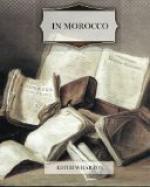The actual mosque, or “praying-hall,” is said to be formed of a rectangle or double cube of 90 metres by 45, and this vast space is equally divided by rows of horseshoe arches resting on whitewashed piers on which the lower part is swathed in finely patterned matting from Sale. Fifteen monumental doorways lead into the mosque. Their doors are of cedar, heavily barred and ornamented with wrought iron, and one of them bears the name of the artisan, and the date 531 of the Hegira (the first half of the twelfth century). The mosque also contains the two halls of audience of the Cadi, of which one has a graceful exterior facade with coupled lights under horseshoe arches; the library, whose 20,000 volumes are reported to have dwindled to about a thousand, the chapel where the Masters of the Koran recite the sacred text in fulfilment of pious bequests; the “museum” in the upper part of the minaret, wherein a remarkable collection of ancient astronomical instruments is said to be preserved; and the mestonda, or raised hall above the court, where women come to pray.
But the crown of El Kairouiyin is the Merinid court of ablutions. This inaccessible wonder lies close under the Medersa Attarine, one of the oldest and most beautiful collegiate buildings of Fez, and through the kindness of the Director of Fine Arts, who was with us, we were taken up to the roof of the Medersa and allowed to look down into the enclosure.
It is so closely guarded from below that from our secret coign of vantage we seemed to be looking down into the heart of forbidden things. Spacious and serene the great tiled cloister lay beneath us, water spilling over from a central basin of marble with a cool sound to which lesser fountains made answer from under the pyramidal green roofs of the twin pavilions. It was near the prayer-hour, and worshippers were flocking in, laying off their shoes and burnouses, washing their faces at the fountains and their feet in the central tank, or stretching themselves out in the shadow of the enclosing arcade.
This, then, was the famous court “so cool in the great heats that seated by thy beautiful jet of water I feel the perfection of bliss”—as the learned doctor Abou Abd Allah el Maghili sang of it, the court in which the students gather from the adjoining halls after having committed to memory the principles of grammar in prose and verse, the “science of the reading of the Koran,” the invention, exposition and ornaments of style, law, medicine, theology, metaphysics and astronomy, as well as the talismanic numbers, and the art of ascertaining by calculation the influences of the angels, the spirits and the heavenly bodies, “the names of the victor and the vanquished, and of the desired object and the person who desires it.”




